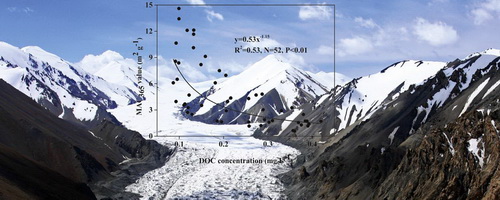In glacierized regions, melting process has a significant effect on concentrations and light absorption characteristics of dissolved organic carbon (DOC), potentially resulting in variations of its radiative forcing, which is not yet relevant research at glacier region of the Tibetan Plateau (TP).
In this study, DOC fractionation and its radiative forcing change during the melting process were investigated at Laohugou glacier No. 12 (LHG glacier) in western Qilian Mts., northern TP.
DOC concentrations in fresh snow, snowpit and surface ice samples were 0.38±0.06, 0.22±0.11 and 0.60±0.21 mg L-1, respectively.
Their mass absorption cross-section at 365 nm (MAC365) were 0.65±0.16, 4.71±3.68 and 1.44±0.52 m2g-1, respectively.
The MAC365 values of snowpit samples showed a significant negative correlation with DOC concentrations, indicating DOC with high MAC365 values were likely to be kept in snow during the melting process.
Topsoil samples of LHG glacierized region likely contributed a lot to snowpit DOC with high MAC365 values due to their similar absorption spectra.
Spatially, the DOC concentration of surface ice samples increased from terminus to the upper part of the glacier.
Correspondingly, the MAC365 value showed decreased trend. In the freezing experiment on surface ice and topsoil samples, small part of DOC with high MAC365 value was also likely to enter first frozen solid phase.
In addition, the radiative forcing caused by snowpit and surface ice DOC increased around 7.64±2.93 and 4.95±1.19 times relative to fresh snow DOC, indicating the snow/ice melting caused by increased light-absorbing DOC needs to be considered in the future research.


